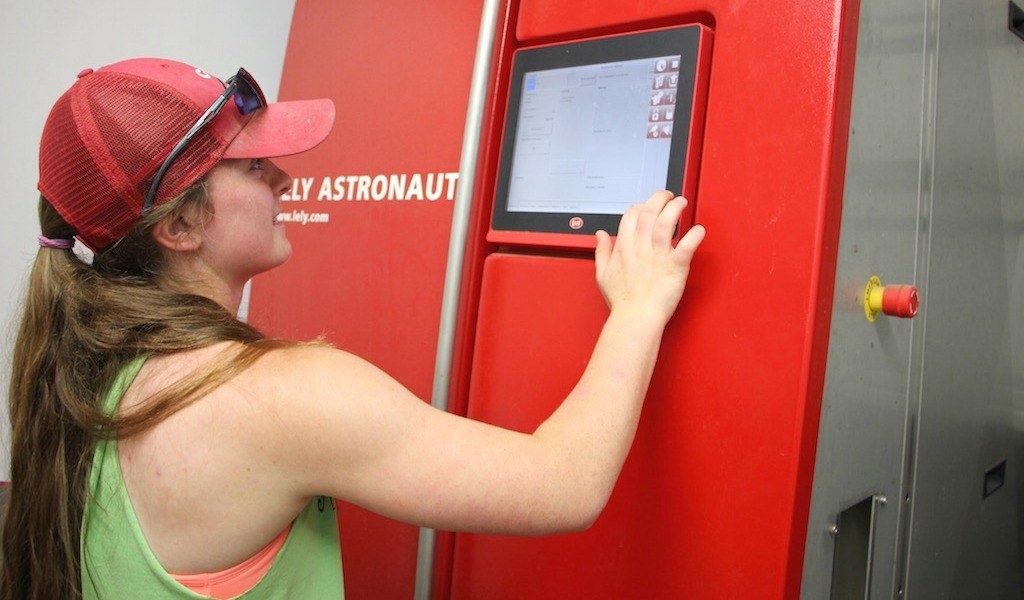1. What are these robots you speak of?
Robotic milking system sometimes referred to as automatic milking systems are devices that milk cows without the need of as much human labor as the conventional milking. The article, Udder health of dairy cows, written by faculty at the University of Helsinki in Finland stated that robotic milking systems were created to replace conventional milking with a milker in a parlor. The article published online in the year 2011 also stated that more than 8,000 farms worldwide were currently using automatic milking systems. Just imagine the number of automated milking systems in 2016.
2. No drugs in this bulk tank
AMS systems can identify milk from treated cows. This insures that only quality milk is in the bulk tank, so you can have a clean glass of milk at home. On DeLaval's website, it states that their Voluntary Milking System (which is their specific version of a robotic milking system) can automatically divert abnormal milk away from the bulk tank while also recording data from the event, so workers will be notified of the incident.
3. Come and go as you please ladies
Cows can voluntarily enter the robot and be milked whenever they wish in certain automated milking systems. Voluntary cow flow can be utilized to increase milk production. The article, Factors associated with increased milk production for automatic milking systems, published in the Journal of Dairy Science in May 2016, stated that free flow cow traffic through the robot was directly correlated with increased production of milk per cow everyday compared to forced systems. Allowing cows to enter the robot when they wish is scientifically proven to increase milk production compared to a forced milking time system.

4. Robots give farmers more free time
Dairy Farmers no longer have to get up before the butt crack of dawn to milk their cows. Robotic milking systems are responsible for milking 24 hours a day. This allows farmers to devote more time towards improving facilities, focusing on cow health and family time. An article written on the Midwest Organic and Sustainable Education Service's website stated how Minnesota dairy farmer Pete Ruegemer stated how thankful he was that the robots gave him more free time around the farm after he implemented two DeLaval robots on his farm in 2011.

5. Lower labor costs
Hiring outside help can be pricey. One expense on dairy farms is hiring outside workers to help with tasks such as milking. A robotic milking system has high start up costs but it will eliminate the need to hire as many outside workers, which will save money. In the scientific article, Automatic Milking Systems, Farm Size, and Milk Production, written by researchers at the USDA Agricultural Service location in Pennsylvania, evaluated the economics impacts of a robotic milking system. The peer- reviewed article stated that farms with approximately 60 cows are the best candidates for successfully implementing a one stall robotic milking system due to certain economic impacts that include but are not limited to start-up costs, milk price, and labor costs.
Citations
Hovinen, M., and S. Pyörälä. 11ADAD. Udder health of dairy cows in automatic milking. Journal of Dairy Science. 94:547–562.
N/A. Voluntary Milking System - Station. DeLaval - US. Available from: http://www.delaval-us.com/-/product-information1/milking/products/stallwork/vms-station/vmsstation/?sp=585
N/A Human Population: Population Growth. Population Reference Bureau. Available from: http://www.prb.org/Publications/Lesson-Plans/HumanPopulation/PopulationGrowth.aspx
Padgham, J. 2013. Robotic Milker Adds Flexibility to Dairy Farm Life. Midwest Organic and Sustainable Education Service.
Rotz, C. A., C. U. Coiner, and K. J. Soder. 2003. Automatic Milking Systems, Farm Size, and Milk Production. Journal of Dairy Science 86:4167–4177.
Tremblay , M., J. P. Hess, B. M. Christenson, K. K. McIntyre, B. Smink, A. J. Van der Kamp, L. G. de Jong, and D. Döpfer. 2016. Factors associated with increased milk production for automatic milking systems. Journal or Dairy Science 99:3824–3837.

